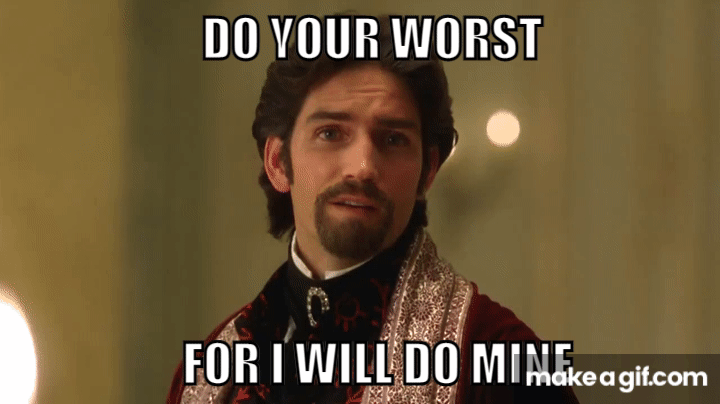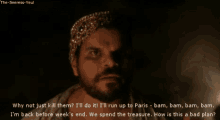Is vengeance ever truly justified? Can justice ever really be attained? These are the questions that lie at the heart of 2002's The Count of Monte Cristo. The film brings Alexander Dumas' 1844 novel to vibrant life, transporting viewers into the heart of an epic saga of injustice, vengeance, and redemption. For classic adventure swing into swashbuckling action with The Count of Monte Cristo.
The story begins in 1815 when sailors Edmund Dantes and Fernand Mondego are forced to seek medical aid for their ill captain. The pair make the desperate choice to come ashore on the heavily guarded island of Elba. In an twist of fate exiled emperor Napoleon Bonaparte convinces his guards to spare the pair and aid their captain. The crafty general then persuades illiterate Edmund to deliver a letter off of the island, promising that its contents are 'entirely innocent'. Edmund naively takes Bonaparte at his word and unbeknownst to him the conversation is overheard by Fernand. Upon returning home Edmund is promoted and becomes engaged to the beautiful Mercedes. Jealous of his friend's happiness, Fernand then goes to the police and informs them that Edmund delivered the letter for Bonaparte. When it is revealed that the letter contained plans for a coup to return Napoleon to power Edmund is imprisoned for treason. His friends and family are then forced to pick up the pieces of their lives, unaware that the supposed end of Edmund Dantes is just the beginning of the Count of Monte Cristo.
Upon the film's 2002 release critics and audiences agreed that it was an adventure the likes of which the phrase, 'they don't make 'em like that anymore' was made. Over twenty years later this sentiment has grown only more strong. In an era in which cinema is dominated by subverted expectations and self-aware irony The Count of Monte Cristo's old-fashioned sincerity is nothing short of refreshing. Rather than using this classic tale of injustice, revenge, and redemption to comment on modern life the film leaves the story to offer commentary on the issues of the day the film instead leaves the source material to speak for itself. In this way the film allows the story to revel in its universal appeal rather than limit it to a niche critique of our own world. The film's refusal to use its script to lecture at audience provides viewers with the opportunity to make their own connections to the work, ensuring a more personal and enriching viewing experience. The film also sets itself apart from its modern counterparts in its refusal to shy away from the emotion of Dumas' original novel. Whereas many modern movies makes their characters' emotions behind self-referential quips and ironic humor The Count of Monte Cristo wears its heart on its sleeve. In exploring Edmund's anguish, longing, and regret the film ensures that viewers will experience these emotions along with him. As a result, his ultimate triumph is that much more inspiring. The film additionally stands out for its expert use of filming locations and practical effects. Rather than relying upon green screen, the film instead utilizes period appropriate location shots. These sets and locations immerse viewers into the world of nineteenth century France from its squalid prisons to its most opulent chateaus. Similarly, the inclusion of dazzling stunt work ensures that Edmund's journey is never less than thrilling. Combines, the effects and locations create a vibrant world of action and adventure which viewers will be hard-pressed to leave. Through its old-fashioned spirit of adventure The Count of Monte Cristo reminds modern viewers of what it means to be a classic.
The film transports viewers to the grit and glamor of nineteenth century France thanks to the work of its star-studded cast. James Frain personifies corruption as compromised prosecutor Villefort. Richard Harris is the mentor we all wish we could have had as Edmund's fellow prisoner, Abbe Faria. Luis Guzman steals each scene in which he appears as pirate turned ally Jacopo. Dagmara Dominczyck aptly blends charm, anguish, and resilience as Edmund's fiancée, Mercedes. Henry Cavill infuses Mercedes and Fernand's son, Albert, with youthful passion and boyish naivete. Guy Pearce is a villain that viewers will love to hate as envious and ruthless Fernand. Jim Cavezial turns in one of the best performances of his career as he takes viewers on Edmund's journey from naive boy to hardened, vengeful, man without missing a single step.
Over twenty years after its release The Count of Monte Cristo continues to dazzle with its epic tale the likes of which cinema was made for. Through its expertly written script the film remains true to the spirit of the original novel while still keeping modern audiences engaged. The stellar cast turn in performances that bring each of Dumas' characters to vibrant life. For an adventure the likes of which dreams, and the movies, were made for set sail with The Count of Monte Cristo.



No comments:
Post a Comment